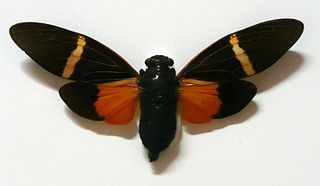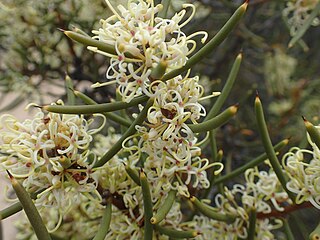
Tiger beetles are a large group of beetles, from the Cicindelinae subfamily, known for their aggressive predatory habits and running speed. The fastest known species of tiger beetle, Cicindela hudsoni, can run at a speed of 9 km/h, or about 125 body lengths per second. As of 2005, about 2,600 species and subspecies were known, with the richest diversity in the Oriental (Indo-Malayan) region, followed by the Neotropics.

Pentatomidae is a family of insects belonging to the order Hemiptera, generally called shield bugs or stink bugs. Pentatomidae is the largest family in the superfamily Pentatomoidea, and contains around 900 genera and over 4700 species. As hemipterans, the pentatomids have piercing sucking mouthparts, and most are phytophagous, including several species which are severe pests on agricultural crops. However, some species, particularly in the subfamily Asopinae, are predatory and may be considered beneficial.

Ranatra is a genus of slender predatory insects of the family Nepidae, known as water scorpions or water stick-insects. There are around 100 Ranatra species found in freshwater habitats around the world, both in warm and temperate regions, with the highest diversity in South America and Asia. Fewer are found elsewhere, but include several African, some in North America, three from Australia and three from the Palearctic, notably the relatively well-known European R. linearis.

The Harpactorinae are a large subfamily of the Reduviidae. About 300 genera and 2,000 species worldwide have been described. Some of the species of the genera Zelus, Pselliopus, Sinea, and Apiomerus are of interest as biological pest control agents.

Sphedanolestes is a large genus of assassin bugs in the family (Reduviidae), subfamily Harpactorinae. There are more than 190 described species, which are found in southern Europe, Africa and Asia.

Harpactor is a genus of assassin bug family (Reduviidae), in the subfamily Harpactorinae.

The Stenopodainae are a subfamily of Reduviidae. Many species of this subfamily are endemic to tropical rainforests, and some smear their fore legs with sticky, plant-derived resin, to aid in prey capture.

Tosena is a genus of cicadas from South-East Asia. They are the type genus of tribe Tosenini. Species formerly included in Tosena are Distantalna splendida, Formotosena montivaga, Formotosena seebohmi and Trengganua sibylla.

Gaeana is a genus of cicadas, most members of which have colourful marking on their forewings, found across tropical and temperate Asia. Their bright wing patterns have been hypothesized as being a case of Batesian mimicry where the toxic models may be day-flying moths of the subfamilies Zygaeninae and Arctiinae. It is closely related to the genus Tosena but is differentiated by the exposed tympanum and lacks spines on the sides of the pronotum.

The Dinidoridae are a small family of insects comprising about a hundred species in sixteen genera in the Hemipteran suborder Heteroptera, the "true bugs". As a group the family does not have any common name. Until the late 19th century they were generally regarded as a subfamily of the Pentatomidae.

Hakea preissii, commonly known as the needle tree, needle bush and Christmas hakea, is a shrub or tree of the genus Hakea native to Western Australia. The Noongar name for the plant is Tanjinn.

Geodorcus novaezealandiae is a large flightless species of stag beetle in the family Lucanidae. It is the type species and smallest member of the genus Geodorcus. It is endemic to New Zealand.

Kinnaridae is a family of fulgoroid planthoppers. This is a small family with a little more than 20 genera and about a 100 species. The family was erected by Muir in 1925 and most members are found in the Oriental and Neotropical regions and only a few in the Nearctic and Palaearctic regions.

Cyclopelta is a genus of Dinidorid bug found in Africa and Asia. There are 14 species in the genus with 8 found in Asia and 6 in Africa. Some species are known to form large aggregation on trees and can cause damage in a few trees of economic importance.

Dundubia is a genus of cicadas in the subfamily Cicadinae and the type genus of the tribe Dundubiini.

Pristhesancus is a genus of insects in the family Reduviidae, the assassin bugs. Species have been recorded from Australia and certain Pacific Islands.
Amulius is a genus of Asian bugs in the family Reduviidae. It has been placed in the tribe Ectinoderini: the 'Oriental resin bugs'.

Monalonion is a genus of bugs in the family Miridae and tribe Dicyphini.

Eurybrachys is a genus of bugs in the family Eurybrachidae. First formally named in 1834 by French entomologist Félix Édouard Guérin-Méneville, Eurybrachys is the type genus of the family Eurybrachidae. The spelling Eurybrachis, by the author, is considered an unaccepted orthographic variant. Species in this genus occur in Asia.
Cercotmetus is a genus of water bugs in the subfamily Ranatrinae. The recorded distribution of this genus is from is from mainland Asia to New Guinea and northern Australia.


















